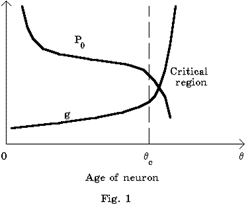2 Spike in neuron
is necessary for neuron itself
The stability of dead matter is determined by the strength
of internal bonds, while the stability of a live matter is provided by
repair activities. Any live unit permanently repairs itself, expending
matter and energy. If there are insufficient matter and energy to
execute the repair, the unit will die. Such a model of oscillating live
unit was considered in [2]. Following this
model the spike in a neuron is understood as an intensive repair state.
The neuron has two main properties: (1) growing old and
(2) an ability to renew itself by means of spikes. The neuron is
characterized by its conventional age q,
which grows in the rest state and decreases at spikes. Age q defines feed that is required by the neuron per
unit of time (energy consumption g). Also age q
defines the neuron's excitability threshold P0,
which is equal to external excitation, sufficient for the transition of
the neuron into the spike state. The main shape of dependencies g(q) and P0(q) is shown in fig.1.

One can see in fig.1, that there is a certain critical age
qc, above
which both g and excitability of the neuron begin to increase rapidly.
The neuron has a certain internal energy reserve H, and its exhausting
involves the death of the neuron. The magnitude of H and the rate of
its variation defines, how does the neuron feel, that is the neuron's
"self-feeling", which influences on the excitability of a certain
neuronal set by means of "field-like" interaction.
The neuron can stay in one of the two states: rest and
transitory state of spike. During the spike the energy consumption
significantly increases, but due to the decrease of q
the total energetic effect of spikes may be positive: at a prolonged
time interval an integral energy consumption will be decreased.
External energetic feed for the neuron is limited, and therefore
neurons are forced to solve the consumption minimization problem. The
method of resolving this problem is the generation of spikes, that can
be expressed by the following thesis: "Spike in a neuron is necessary
for the neuron itself, not for the brain". The mean of solution of this
problem is the functioning of interneuron links, creating conditions
for the mutual stimulation of spikes.